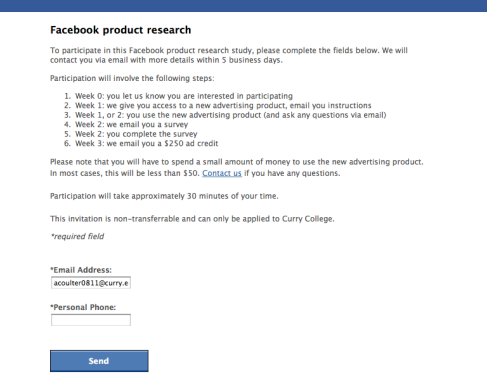As Social Media Specialist at Curry College in Milton, MA, I manage a bunch of Facebook Pages and was recently presented with a cool opportunity from Facebook to participate in a product research study (applicable to just one of the college’s pages – the main, institutional one.) I have dabbled in using ads (mainly ‘Sponsored Stories) on the site, and have experienced solid results driving page likes, and by participating we would receieve a $250 ad credit – a no brainer. Plus I was curious to use the new ad product.
The ad product we would be testing out and providing comments on is called “Promoting Posts.”
Full Promoting Posts PDF Guide.
We had Commencement coming up fast, so I worked with our graphic design department to create a jpg. announcing how our community could use social to interact with each other, friends, family and staff during the ceremony and that we could then post and “promote.” At that time we had been reaching on average 600 people per post (I just created the page in September 2011). So, I promoted the post for $5.00 and monitored closely (you can promote a post that you’ve created within the past 3 days just by clicking “Promote” under the post.) The promotion runs for 3 days automatically and you can pause or stop the promotion of the post (which can be photos, status updates, offers, videos and questions) before the 3 days are up. From what I saw and was told the promoted post is pushed into more newsfeeds than normal of a pages’ fans and for people interacting with the post (liking it, commenting, sharing etc.), into more of their friends newsfeeds – thereby increasing awareness and hopefully, Actions.
Importantly, when being served up in the newsfeed it’s fairly subtle that it’s a promoted post, as the only sign is the word “Sponsored” displayed under the post.
Also, the post becomes a “Sponsored Story” being displayed in the right hand column with your friend’s names who liked it, commented on it or shared it attached.
Here are the results of the 3-day campaign to promote our “pre-commencement social graphic:” (Note the 19 Actions are just for the post being displayed in newsfeeds, when it was simultaneously served up as a Sponsored Story it received 14 more Actions. You can see these results in the same Campaigns and Ads section in Facebook, and under the first screenshot below.)
So, as you can see we reached more people than average (although, this bump might be explained by Commencement being our biggest event of the year, and the social media call to action) – but Facebook also provides a couple other cool metrics by which to judge the campaign’s success – Click Through Rate (CTR) and Actions. I was happy with the 9.555% CTR and can see promoting an interesting post that points to your website working quite well. In terms of the 33 Actions, I wasn’t as happy, as we’ve experienced many more than that organically on a similar photo post.
At the end of week two I was emailed a brief survey, completed it and was indeed sent the ad coupon code. So, all-in-all I was happy to have participated and if/once this ad product is available for all, I would try it again (especially to see how successfully it works driving folks to our website or a landing page). What do you think? Are there negative implications for a brand paying to promote one of their posts?
Note: I posted the pre-commencement social graphic normally (not using the ad product) one day before promoting it, so the slight discrepancy in likes, comments and 1 share shown in the screen shot above is due to this fact. The total 33 Actions is just for the campaign.





























